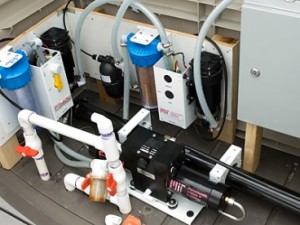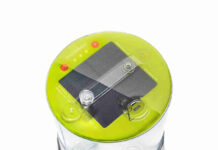 Systems which can remove salt from salt-water, or desalination systems, have existed for decades, but they are typically large-scale installations that require lots of energy to operate.
Systems which can remove salt from salt-water, or desalination systems, have existed for decades, but they are typically large-scale installations that require lots of energy to operate.
As bottled water was given the highest priority in terms of airborne relief supplies in Haiti, what relief teams needed were small, portable, self-contained desalination systems that could turn seawater into drinking water without using exterior electrical power.
A team from MIT’s Field and Space Robotics Laboratory (FSRL) in the Department of Mechanical Engineering has designed a solar-powered desalination system that could be rapidly deployed in crisis situations to produce drinking water. The portable system could also be used in remote areas where supplying energy and clean water can be logistically complex and expensive, such as desert locations or farms and small villages in developing countries.
Led by Steven Dubowsky, a professor in both the Department of Mechanical Engineering and the Department of Aeronautics and Astronautics, and graduate students Amy Bilton and Leah Kelley, the group built a small prototype of desalination system last spring to test algorithms they had developed to run it. They have since demonstrated that the prototype is capable of producing 80 gallons of water a day in a variety of weather conditions. They estimate that a larger version of the unit, which would cost about $8,000 to construct, could provide about 1,000 gallons of water per day and also estimate that one C-130 cargo air-plane could transport two dozen desalination units — enough to provide water for 10,000 people.
The research is aimed to design at small-scale systems for remote regions that don’t have access to vast amounts of electricity and are also designed to be cost-effectively assembled from standard parts and put into operation within hours using local human capital. Another objective is to create a device that can operate efficiently over a range of solar conditions.
Unlike conventional solar-powered desalination systems that run on expensive, short-life batteries when it gets cloudy, this system is designed for “optimal control,” meaning that the system’s computer can change certain variables, such as the power of the pump or the position of the valves, to maximize water output in response to changes in sunshine, temperature and water demand. Various sensors are connected to a control computer that alerts operators when to make these changes. “If it’s very sunny, the system will work faster and produce more water, but even when it’s cloudy, it will still produce water,” says MechE graduate student and team member Kelley.
Technically the system relies on reverse osmosis, a filtration method that removes molecules and ions such as salt from solutions by applying pressure to the fluid as it flows over a permeable membrane. This process begins as photons, or particles of light from the sun, fall onto a solar photovoltaic panel and excite electrons in that panel. This activity generates electric power that pushes seawater through various pumps until it is sent – at extremely high pressure – into a vessel that has a permeable membrane made of polymer material. As a result of the high pressure, the water that diffuses through the membrane has had minerals removed.
The research project for this kind of devices was funded by MIT’s Center for Clean Water and Clean Energy in collaboration with the King Fahd University of Petroleum and Minerals (KFUPM). The prototype system was presented as a paper reporting preliminary results last week at the “EuroMed 2010-Desalination for Clean Water and Energy Conference” held in Tel Aviv, ISRAEL.



